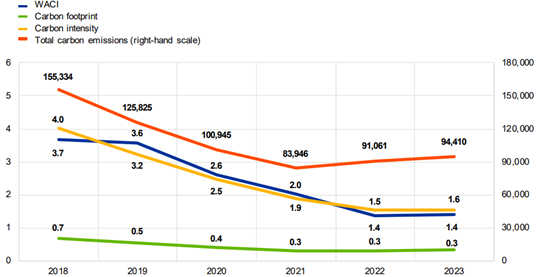Announcements
Drinks

Pressure mounts to improve climate-risk disclosures in covered bonds
By Karlo Fuchs, Head of Covered Bonds
Closing the green finance investment gap is a strategic priority for the EU, driving sustained policy and regulatory focus on climate and environmental sustainability. The European Central Bank is committed to setting a precedent and has published climate risk disclosures for its bond holdings – including covered bonds – held for both monetary and non-monetary policy purposes.
For corporate bonds, holdings under the Corporate Sector Purchase Programme (CSPP) and Pandemic Emergency Purchase Programme (PEPP) already incorporate climate-risk considerations. These programmes prioritise issuers with better climate performance or green bond issuance. However, applying similar climate-risk considerations to covered bonds presents challenges when re-investing or for monetary operations, given the relatively small share of ESG labelled bonds in the market. Year-to-date, ESG-labelled bonds from euro-area issuers have accounted for just 11% of the USD 102bn in total issuance.
Beyond ESG labelling, the ECB relies principally on ESG disclosure from the first recourse issuers. From a data-quality perspective, this approach is not perfect. Scope 1, 2 and 3 emissions are self-reported by issuers or approximated using external sources. Only large institutions are obliged to publish information about ESG risks in their pillar 3 reports (CRR Article 449a) but even then only biannually. Smaller institutions will only begin reporting in their annual reports for 2025.
Given the Capital Requirements Regulation is binding for banks, the availability of high-level, relatively consistent portfolio-based information is crucial. This will help the ECB to systematically assess first-recourse: issuers. This information has already allowed certain developments to be identified regarding the climate-risk footprint of its covered bond holdings.
ECB climate-risk metrics of covered bond holdings under CBPP3 and PEPP
Left-hand scale: tCO2e/EURm; right-hand scale tCO2e

Data sources: ISS, Carbon4 Finance, World Bank, Bloomberg and ECB calculations.
Notes: The chart shows historic values of the key metrics for the covered bond holdings held for monetary policy purposes under the CBPP3 and PEPP, based on issuers’ scope 1 + 2 emissions. Metrics are calculated using bonds’ nominal values. Emissions normalisation in the Weighted Average Carbon Intensity (WACI) and the carbon intensity metrics is based on revenue in € millions; in the carbon footprint metric, emissions normalisation is based on the investment amount in € millions. Underlying holdings refer to year-end values
Source: ECB
Issuers certainly face challenges in collecting and providing high-quality ESG information about their cover-pool exposures. Currently, only a third of issuers that report cover pool information using the European Covered Bond Council’s (ECBC) Harmonised Transparency Template (HTT) to provide voluntary ESG-related cover-pool information in their reports. Even if the quality and number of reporting issuers is increasing, which is a positive development, meaningful comparisons remain elusive. From a credit perspective, consistently identifying credit-risk drivers due to the inconsistencies in reporting is challenging.
The low share of issuers reporting ESG information in their HTTs is surprising, especially as the number of ESG issuers is growing. ESG-themed covered bonds come with a regular reporting requirement but it is often easier to obtain the data for selected collateral than for the entire pool.
Improved ESG cover-pool transparency will only emerge under pressure
The ECB has explored the possibility of whether credit rating agencies can provide additional information and is monitoring and encouraging advancements in this area (see Disclosure of climate change risk in credit ratings). The ECB is also promoting climate-risk assessments at Eurosystem level, establishing minimum standards that national central banks must abide by from 2025. But despite repeated efforts by the Bank to accelerate ESG disclosure, progress has been slow.
At the ECBC’s 2024 spring plenary meeting in Reykjavik, the European Banking Authority shared some initial thoughts about how cover-pool transparency could be further formalised. Transparency might become part of additional Pillar 3 disclosures or be included in the next update of the European Covered Bond Directive (CBD), where the disclosure framework could be further improved. That could ultimately mean that consistent and regular ESG disclosure becomes relevant for preferential risk weights and covered bond treatment for Liquidity Coverage Ratio purposes.
As seen with the CBD, political processes often result in compromises and it can take a long time for them to take effect for all issuers. From start to finish, the CBD almost took a decade and mandatory and enhanced regular cover-pool transparency only became mandatory with the introduction of the CBD in 2022. From July 2017, five years prior to the CBDs effective date, the ECB already made regular and enhanced cover pool reporting a mandatory requirement for covered bonds that are used for monetary liquidity operations (see Annex IXb).
Will the ECB wait for an industry compromise or spearhead developments? In the end, the ECB remains the single largest investor in covered bonds and issuers would have a hard time if they do not follow its expectations.
Stay up to date with Scope’s ratings and research by signing up to our newsletters across credit, ESG and funds. Click here to register.






